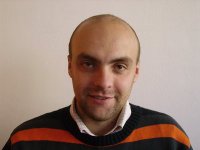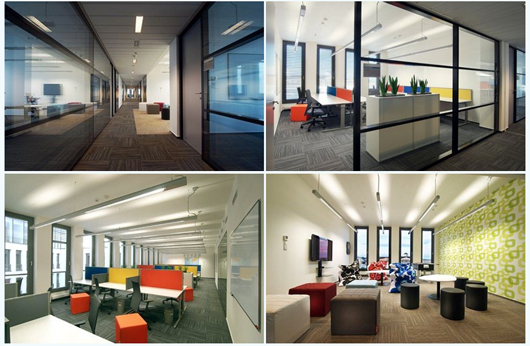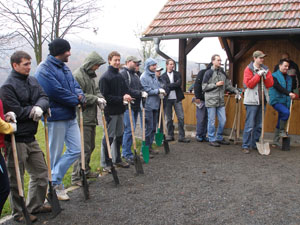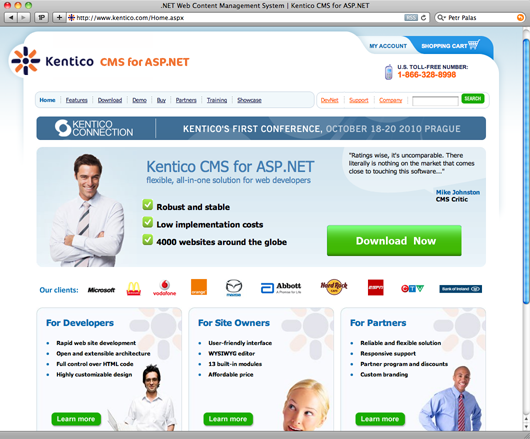Below: Q&A with Petr Palas, CEO and Co-Founder of Kentico Software (based in The Czech Republic). He also answered reader questions in the comments. This is part of our “Bootstrapped, Profitable, & Proud” series which profiles profitable companies that didn’t take VC and have over $1 million in annual revenues.
What does your company do?
 We help web developers have more fun creating websites. We have a single product called Kentico CMS for ASP.NET. Now you may think it’s just another boring CMS. Well, it may be. But we believe it’s different. Most CMS systems are either very simple and thus easy to use or they are extremely flexible and complex. We decided not to make decissions between simplicity and flexibility and mix both of them in a single product. So we built a CMS that makes web developers much more productive, but also allows them to design the website in the way they need.
We help web developers have more fun creating websites. We have a single product called Kentico CMS for ASP.NET. Now you may think it’s just another boring CMS. Well, it may be. But we believe it’s different. Most CMS systems are either very simple and thus easy to use or they are extremely flexible and complex. We decided not to make decissions between simplicity and flexibility and mix both of them in a single product. So we built a CMS that makes web developers much more productive, but also allows them to design the website in the way they need.
How did the business get started?
I was building some websites and web applications and realized there’s a lot of routine work I hated. I believed there must be an easier way to do things. I worked in a company that created several .NET components for developers and then I saw there was no good CMS for ASP.NET developers. I suggested that to the employer, but they didn’t see that as an opportunity since there were many web agencies selling their own simple CMS products. So I decided to start my own company in 2004, just with my savings. I gave up my master studies of computer science and put all my efforts and time into my company.
And I was actually lucky, since my first client was Gibson Guitars who decided to use Kentico CMS for their website, although the product was very immature (and they’re still our client!). At that time, I didn’t have any strategy or big vision. I didn’t watch the market and competitors. I just followed what our clients were asking for and tried to add those features as quickly as possible. Thanks to that, we’ve had some features, such as friendly URLs and SEO optimized pages, years ahead of big CMS companies. As we implemented what the clients wanted, we were growing rapidly with every new release.
I didn’t have any strategy or big vision. I didn’t watch the market and competitors. I just followed what our clients were asking for and tried to add those features as quickly as possible.
Then I was lucky again and got a contract for some development based on Kentico CMS for T-Systems, a division of T-Mobile. It gave me some extra money and I immediately invested it into further growth of the company.
I hired three university students as developers to speed up the development. We used students a lot since they were much cheaper and easier to hire for a start up company. At some point, we had 25 employees, 20 of which were students. We still have students in our team, but the ratio is much lower, it’s about 15% now.
As they graduate, they continue as full-time employees. The stability of our team is actually something I’m proud of – we’ve never lost an employee who was excellent and for which the job was a good fit. Now, after 6 years, we have 62 employess, 4 of them in our U.S. office.
That leads me to one important part of the story: We’re not an American company. We’re not even in Western Europe. We are located in the Czech Republic, a former communist country in Central Europe. Still, we managed to grow our client base to 2,000 clients in 84 countries without ever meeting most of them.
At the beginning, I decided I wanted to make the product for the global market since the market size was enormous in comparison to our local market. So I started to sell the CMS online, without any sales staff and with a very small marketing budget that I spent mostly on Google Adwords. We ranked very high at Google because most of our big competitors didn’t bother with SEO at that time. It gave us lots of traffic. We’re constantly trying different approaches to marketing, but it seems to me that the return for every extra marketing dollar is smaller and smaller.
How much cash did you need to get up and running?
I started with $10,000 which was my savings. I knew I needed to build something small and start selling it before I ran out of money. I didn’t consider any external funding or taking loans. In fact, I still do not consider anything like that. I have a strong belief that every company that has a good business model doesn’t need external funding, at least in software or online business where the entry costs are very low.
I have a strong belief that every company that has a good business model doesn’t need external funding, at least in software or online business where the entry costs are very low.
How successful is your business?
I can confirm we meet the criteria of this series. We do not publish our numbers, although I would love to publish them. We try to be transparent in everything we do. For example, we publish all bugs found in our software and fix them within 7 days, something you won’t see with most commercial software companies. However, as we’re competing head-to-head with larger companies, but at a much lower price, publishing the numbers would not be in our favor. All I can say is that we were growing by 100+ percent for several years in a row and we’ve been consistently profitable since the first year on the market.
In 2008 and 2009, we were named a Deloitte FAST 50 Rising Star, ranking us as one of the fastest growing young technology companies in Central Europe.
What is your work environment like?
Open, friendly, easy-going, but with a high focus on productivity and getting things done. On the one hand, we have a relaxed space with darts and foosball, a café, and two dogs in our office.
On the other hand, we use some very traditional management tools, such as clear organizational hierarchy, work manuals, statistics, performance reviews and internal policies. Everybody has to contribute. And I’m glad to say that all of our people have the inner motivation for this, so we don’t have to push.
Still, I would say we’ve never had the start-up spirit of people working day and night, sleeping in the office. We’ve always been more like a traditional nine-to-five company. Most of our employees do not work more than 40 hours per week and I must say I actually find this model more sustainable. If you’re doing long hours for too long, your work-life balance will eventually suffer and you will find yourself less productive and motivated.

Photos of Kentico’s new office.
If you’re doing long hours for too long, your work-life balance will eventually suffer and you will find yourself less productive and motivated.
What’s your goal with the company?
Well, we certainly have goals and milestones, but I can’t say I have a single, final goal with the company, one that I could achieve and then do nothing. I want to build a great company that makes something valuable, that is loved by the clients and where people love to work. It’s a never-ending journey to perfection that you can never achieve.
What’s been the biggest challenge you’ve had to overcome as a company? The beginning with a tight budget and no sales was certainly a challenge. I spent 6 months working on the product without making a single penny, seeing my savings shrink every day. I remember one early morning when I was walking on the street and met a sweeper and I thought to myself “what a happy guy, he works and gets paid every month.”
I had to change my mind about systems. When I left my job and started my own company, I decided to build a company without rules, systems and bureaucracy. But at the point when we grew to 20+ employees, we had to implement many systems and formalized processes to keep the company organized and productive. And I become fond of systems – they made my job easier. Well thought-out systems mean more fun for our team as everybody knows what to do. It’s a never-ending process of continuous improvement of everything we do.
The last big challenge started when we reached the point when we were able to close large deals. It required a completely different approach to our previously online-only sales. We had to grow the sales team and approach the whole business more strategically.
I must say I actually enjoyed all those challenges as they made me think and learn something new every day.
What else is interesting about your story?
In 2009, we ran a successful program called Trees for Bugs to promote our 7-day bug fixing policy.
 We planted a tree for every bug reported by our clients with a label containing the name of the client. We didn’t just send money to some NGO to plant the trees for us. We actually went out and planted them ourselves. And it was the best team event I’ve ever been to. If you’re looking for a team building activity for your employees, let them do something useful for someone else. You can see pictures here.
We planted a tree for every bug reported by our clients with a label containing the name of the client. We didn’t just send money to some NGO to plant the trees for us. We actually went out and planted them ourselves. And it was the best team event I’ve ever been to. If you’re looking for a team building activity for your employees, let them do something useful for someone else. You can see pictures here.
What advice do you have for someone considering starting a business?
Many people think they need to have a unique, revolutionary idea to start a successful business. So they keep waiting for that idea until they retire. Don’t wait. Figure out what you love to do and look around you. You will find many opportunities on the existing markets where customers do not get what they need or get a poor service. Figure out if you can do it better and if you is can build a profitable business model around it. Once you’re fully convinced this the thing you want to do, go and do. Don’t waste your time with hundred-page business plans and presentations for VCs. Just do it.
Don’t waste your time with hundred-page business plans and presentations for VCs.
Just do it.
Visit Kentico Software
More “Bootstrapped, Profitable, & Proud” posts [Signal vs. Noise]


Jermaine Oosterling
on 09 Sep 10Very cool story. One of my favorites. However reading this piece:
...I was walking on the street and met a sweeper and I thought to myself “what a happy guy, he works and gets paid every month.”
—does this mean that you’ve basically quitted your day-to-day job before building your own company?
Dimitris Rakopoulos
on 09 Sep 10Great story, very good company, a great product. We’ve been on board with Kentico for a couple of years and they’ve helped us build easily some great websites.
Keep it up. We will meet in October in Prague on the conference.
Scott
on 09 Sep 10I love how so much of the bootstrapped experience is summed by this I remember one early morning when I was walking on the street and met a sweeper and I thought to myself “what a happy guy, he works and gets paid every month.”
I know exactly the feeling, Petr, where you think “man life would be so easy if I just were happy getting up, doing a job, and going home”. I’m glad you stuck it out and found success as what you wanted to do. Well said and thanks for sharing this inspirational and insightful story.
Scott
on 09 Sep 10Petr,
In a June blog post introducing the new offices, you give a history of Kentico. There you share that you “rented a small room in the office of my friend’s company and started developing Kentico CMS 1.0.” From the photo in that post, it seems little more than a table, bookshelf, and chair is all you needed.
So, my questions are:
1.) At that stage where you had no revenue yet, why did you feel the need to rent space vs. developing from a kitchen table or bedroom desk?
2.) Would you recommend an offsite, dedicated office space to new bootstrappers today?
Vojto
on 09 Sep 10Petr,
what did you feel like about entering global market. Czech republic has small market, but you knew it much better – I mean things might be totally different in global/US market.
Wasn’t you afraid of that? How did you prepare? How did you learn about global market?
Petr Palas
on 09 Sep 10Jermaine: Yes, I quit my daily job and started the company without having any income from the business during the first months. I decided to focus all my efforts on Kentico CMS rather than jumping between job and business.
Petr Palas
on 09 Sep 10Dimitris: Thank you for your kind words. Looking forward to meeting you in Prague! That’s why we hold this conference – to meet with our clients face to face instead of just exchanging e-mails.
Petr Palas
on 09 Sep 10Scott: Well, there were two reasons: I was living in an apartment with poor Internet connection and second, I needed to go to office, just to feel like I’m actually working. I wasn’t able to really concentrate on work at home. When I think about it, it was probably the most productive time in my life.
On the other hand, if you’re comfortable working in a home office, I would recommend to save every dollar you can and use it wisely for actually developing your business.
Petr Palas
on 09 Sep 10Vojto: I actually started with global market in mind. I had already had some experience with selling .NET components on the global market from my previous job, so I decided to build a CMS for developers and sell it through the same channels. It was a cost-free and highly efficient way to get the product on the market.
Still, we moved to a more traditional sales model later on as our product matured. We’re now selling mainly through our partner network – web design agencies that use Kentico CMS to build websites for their clients. And these partners leverage their knowledge of the local markets to sell the product to the end clients. Some of them even localize Kentico CMS to their language, so we now have several translations thanks to our partners.
I must say we’re not utilizing the opportunities on local markets and there’s a lot of potential in going local rather than staying global. Still, I think it’s easier to build your business globally (or nationally if you’re in the U.S.) at the beginning and then develop local markets if your business model allows that because there’s always someone who needs and buys your product somewhere in the world. And getting that very first sale is the cruicial moment in your business.
GregT
on 09 Sep 10This guy listens to his customers, which is the antithesis of the 37s philosophy…. I’m surprised you are showcasing a company that doesn’t perfectly confirm your philosophies, but it’s a step in the right direction.
dude
on 09 Sep 10Oh shush-it GregT, you have no idea what you’re talking about.
Michal Illich
on 09 Sep 10Good luck, Kentico!
Glad to see another globally successful Czech company.
Dylan
on 09 Sep 10Petr, what did you mean when you wrote, “We’re constantly trying different approaches to marketing, but it seems to me that the return for every extra marketing dollar is smaller and smaller.”?
Thanks! Dylan
Joseph Cooney
on 09 Sep 10Nice to see a company using the Microsoft technology stack being featured, given 37signals Apple/Open Source culture. Plus their office looks gorgeous.
Christopher Hawkins
on 10 Sep 10I’ve been using Kentico since version 3.1 and have multiple sites running with it. It’s a uniformly good system for end users, and a pretty good system for developers. You can plug a User Control into any page, and creating your own Web Parts is easy too.
Overall, I’m pleased. If I weren’t I wouldn’t keep suggesting Kentico to my clients. Congrats on building a cool product and a cool company.
Petr Palas
on 10 Sep 10Dylan: We started with Google AdWords campaigns at the very beginning and these proved to be the best marketing investment over all years. We tried many other marketing channels, such as banners, paid product showcases, newsletter sponsorships, tradeshows, etc. and kept those that work, but it becomes more and more difficult to find more of them that really deliver results for the money you invest.
Petr Palas
on 10 Sep 10Christopher: Thank you for your kind words and long-term support. We wouldn’t be where we are now without partners like you.
Jeroen Fürst
on 10 Sep 10Great story indeed! We at IBL-Software really enjoy to work with Kentico and hope we can continue our collaboration in the future. I really liked the Office Walkthrough and to see those familiar faces!
Petr Palas
on 10 Sep 10Thank you, Jeroen!
Name
on 10 Sep 10I don’t mean to be negative but “walkthrough” is spelt wrong in the video title!
Name
on 10 Sep 10I don’t mean to be negative but “walkthrough” is spelt wrong in the video title!
Petr Palas
on 10 Sep 10Name: thanks for pointing that out. We will fix it next week.
Rob
on 11 Sep 10Petr: Just wanted to say I found your story inspiring. Keep up the good work.
Mark V
on 11 Sep 10Petr.
Your story has given me inspiration and motivation to start my own business. In your story you mentioned that you stopped working on a Master’s in computer science-can you tell me what you did study in college, and what kind of degree you did get?
Petr Palas
on 12 Sep 10Mark V: I’ve got BSc. in computer science and then I continued towards MSc. degree, but I quit since the classes were too far from what I needed in my job (I was working as developer and later product manager during my studies). Unfortunately, I cannot say that I would use much of what I learned at the college in my job.
Still, I cannot recommend quitting school to everyone – when I quit studies, I already had 5-year experience in software development, so even if my new business had failed, it would have been easy for me to find a job. Also, I already had a knowledge of the market when I started Kentico, which made it less risky.
Petr Palas
on 13 Sep 10Name: Just FYI: we fixed the typo, the updated video is here: http://www.youtube.com/watch?v=S2p-ybHqoWo
(unfortunately, the original video is already embedded at several places and YouTube doesn’t allow us to update it).
Joel Dahlin
on 15 Sep 10Great story Petr. I’ve been a user of Kentico since 3.0 and am always happy with the new releases. I like that you are very transparent with your company and your support team is awesome.
Very cool to hear you built your company on your own savings.
Keep up the great work.
Troy Fulton
on 15 Sep 10Great Story Peter,
We have adopted Kentico as our core framework for all projects we work on, and are even developing a product line of SAAS Services that uses Kentico as it’s core. We would really struggle to make the strides we do without it.
We’ve been using Kentico since version 3.0 and have really enjoyed the ride. It has been great working with your team, and as you know, I’ve had the pleasure of meeting some of your team.
Keep doing what you do!
Petr Palas
on 15 Sep 10Joel and Troy: Thank you for your kind words and support!
This discussion is closed.